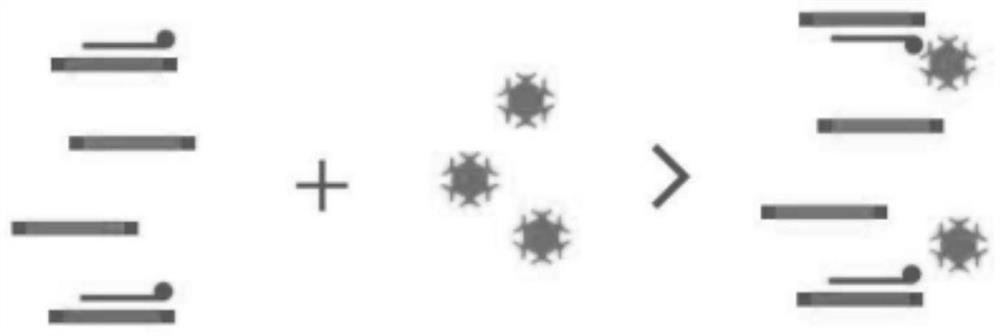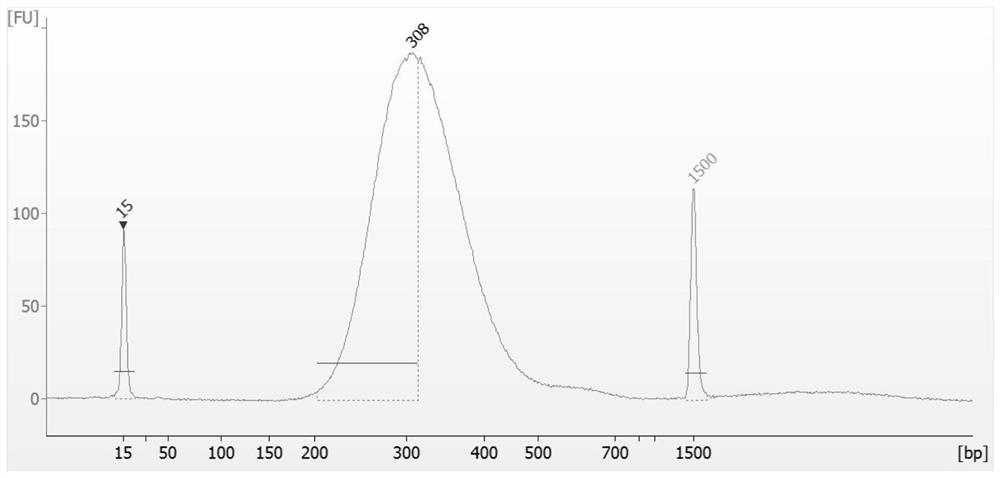Probe set for detecting tuberous sclerosis gene mutation and kit thereof
A probe set and kit technology, applied in the field of molecular biology, can solve problems such as heavy workload, high price, and low frequency of gene mutation
- Summary
- Abstract
- Description
- Claims
- Application Information
AI Technical Summary
Problems solved by technology
Method used
Image
Examples
Embodiment 1
[0041] Such as figure 1 Shown is the detection flow chart of this embodiment, and the specific experimental process is as follows:
[0042] 1. Probe design and dilution
[0043] According to the liquid-phase hybridization capture technology, a set of DNA capture probes was designed. The length of the TSC1 gene is 53359bp, and a total of 394 probes were designed, and the length of each probe was about 110nt to 120nt, and the length of most probes was 120nt; It is 110nt~120nt, most of the probes are 120nt in length, and the probes cover all exons and exon-intron junction regions.
[0044] Dilute the dry probe powder synthesized by Integrated DNA Technologies with IDTE Buffer to a working solution with a concentration of 100 amol / μL. The specific dilution method is:
[0045] After centrifuging the dry powder of the probe, open the cap and add 100 μL IDTE (diluent prepared by Integrated DNA Technologies), mix well, and let it stand overnight at 4°C. At this time, the storage st...
Embodiment 2
[0093] Previously positive sample A1 (peripheral blood) provided by Shenzhen Anji Kanger Medical Testing Laboratory. The subject of this sample had recurrent bouts of stupor for 6 years, focusing on the investigation of tuberous sclerosis genes. It was adopted by Anji Kanger Medical Testing Laboratory Nanodigmbio's The detection result of the whole exome detection technology done by the Hybrid Capture Re agents kit is a TSC1 gene mutation, and the mutation site is NM_000368.4:c.1757del, which is detected by the method of this embodiment, such as figure 1 The detection flow chart is shown, and the specific detection method is as follows:
[0094] 1 DNA sample fragmentation
[0095] 1.1 Adoption dsDNA HS Assay Kit Fluorescent Quantitative Kit, check the sample concentration according to the operation of the quantitative kit, take 1 μg of qualified gDNA sample, and dilute the sample with 1×TE buffer solution (10mM Tris-HCl, 1mM EDTA, PH=8.0) to the specification volume of th...
Embodiment 3
[0260] Previously positive sample A2 provided by Shenzhen Anji Kanger Medical Laboratory. The subject of this sample was admitted to the hospital due to repeated convulsions for more than 5 years and fever for 1 day. Physical examination: a brown rash of about 3cm in size can be seen on the neck, showing a shark skin rash. There are multiple depigmentation spots all over the body. The initial diagnosis was tuberous sclerosis. The Shenzhen Anji Kanger Medical Testing Laboratory adopted Nanodigmbio's The detection result of the whole exome detection technology made by the Hybrid Capture Reagents kit was negative, and the method of Example 1 was used for detection. From the detection results, it was found that the TSC2 gene of sample A2 had a mutation in the intron region, and the mutation site It is NM_000548.3:c.848+281C>T(intron_variant), Intron9 / 40. Sanger sequencing was used to verify this site in the family sample, and the sequencing result was consistent with the detecti...
PUM
| Property | Measurement | Unit |
|---|---|---|
| Gene length | aaaaa | aaaaa |
| Gene length | aaaaa | aaaaa |
Abstract
Description
Claims
Application Information
 Login to View More
Login to View More - R&D
- Intellectual Property
- Life Sciences
- Materials
- Tech Scout
- Unparalleled Data Quality
- Higher Quality Content
- 60% Fewer Hallucinations
Browse by: Latest US Patents, China's latest patents, Technical Efficacy Thesaurus, Application Domain, Technology Topic, Popular Technical Reports.
© 2025 PatSnap. All rights reserved.Legal|Privacy policy|Modern Slavery Act Transparency Statement|Sitemap|About US| Contact US: help@patsnap.com



